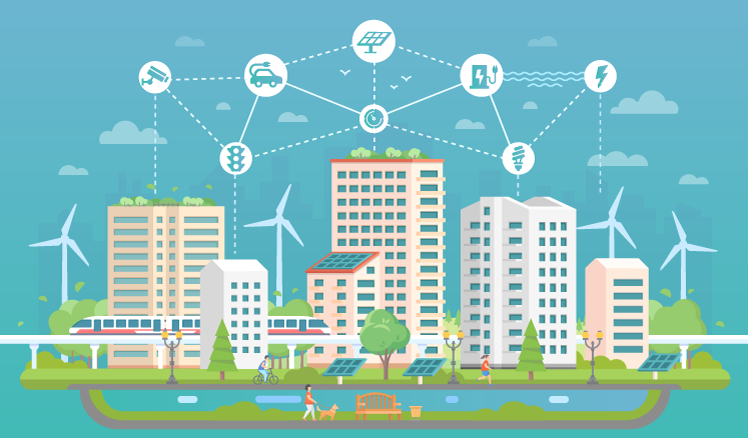
Building the Future: IoT and Smart Cities
For over 6,000 years, cities have grappled with the same issues: sanitation, crime, traffic, public facility maintenance, and emergency services. But with technological advancements, new infrastructure has become necessary for cities to function smoothly. These include the electric grid, telephone and cell networks, internet connectivity, water and waste treatment facilities, and transport systems. Smart cities are now emerging as a solution to these issues.
By utilising the Internet of Things (IoT), cities can monitor both residents and infrastructure in real-time. This allows for continuous improvement in the delivery and quality of services, while also enabling prompt communication of any issues that may arise. A secure and sustainable approach to smart cities is needed to ensure that the privacy and security of residents is protected, while also minimising the environmental impact of these technologies. By prioritising these factors, cities can create a more efficient and equitable future for their residents.
The advancement of technology has paved the way for the concept of a smart city, which relies heavily on automation, internet connectivity, and IoT. IoT involves connecting internet-enabled devices that can be controlled or used to send data and statistics.
In a smart city, hundreds or thousands of sensors are deployed to collect electronic data from people and infrastructure.
This data is used to improve the efficiency and quality of life for residents. City workers and residents can access city services, report outages, accidents, and crimes, pay taxes, and fees all through centralised through apps. Sustainability and energy efficiency are emphasised in the smart city. The use of technology and connectivity allows for better management of resources and a reduction in waste. Overall, the smart city aims to enhance the quality of life for its people while promoting sustainability.
Smart cities are built upon a foundation of advanced Information and Communication Technologies (ICT). These technologies provide a framework for sustainable development practices that can address the challenges of rapidly growing urbanisation. By leveraging the power of ICT, smart cities can develop and deploy innovative solutions that promote sustainability and enhance the quality of life.
Smart Energy
Efficient and reliable power distribution is the primary goal of any electric grid. However, power outages and faults as we know, can disrupt service and cause major, continued damage if not mitigated. To address this, smart meters have emerged as a digital solution that can replace the outdated, mechanical meters that require monthly readings. Smart meters offer more timely monitoring of individual usage and can communicate wirelessly, eliminating the need for personnel to enter backyards. Additionally, these meters enable utilities to more quickly identify the source of power outages, minimising downtime and damage.
With smart meters, controlling electricity consumption from a centralised location has become easier than ever. Utility crews are no longer required to physically switch appliances on or off. The advanced technology also allows differential rate provisioning, where consumers can be charged higher rates during peak hours. By having timely access to their consumption data, users can adjust their energy usage accordingly and save money.
Microgrids are another exciting development in the utilities industry. These interconnected sources and loads can operate autonomously as an “island” or as a backup to the larger grid in the case of a failure. They are also more efficient and can greatly improve energy management. Even streetlights are being transformed into smart devices as part of smart city initiatives.
Cities are fast replacing old streetlights with LEDs for more efficient energy consumption. With these updates, cities are becoming smarter and more sustainable.
The ICT Framework
The ICT framework comprises a sophisticated network of connected objects and machines, commonly referred to as a digital city. These intelligent devices transmit data wirelessly to cloud-based IoT applications, which analyse and manage the information in real-time.
This results in better decision-making for municipalities, businesses, and citizens, leading to an overall improvement in quality of life. The citizens can interact with the smart city ecosystem through their smartphones, mobile devices, connected cars, and homes. By integrating these devices with a city’s physical infrastructure and services, costs can be reduced, and sustainability can be improved. Communities can leverage the power of IoT to optimise energy distribution, streamline trash collection, reduce traffic congestion, and enhance air quality.
For example, the implementation of smart city technologies is revolutionising how we manage public infrastructure, mobility, and utilities.
- Traffic lights equipped with sensors and connected to cars can adjust their timing in real-time, reducing road congestion. Imagine a city where connected cars communicate with parking meters and EV charging docks, directing drivers to the nearest available spot, or not being the only car in an intersection, sitting waiting for a green light!
- Smart rubbish bins that can automatically send data to waste management companies and schedule pick-up for much needed improved efficiency of waste collection.
- And for the community, their smartphone can now serve as a mobile driver’s license and ID card with digital credentials, simplifying access to city services.
These technologies are working together to optimise the functionality of our cities and improve our daily lives.
Why do we need smart cities?
Smart cities are the need of the hour considering the ongoing urbanisation phenomenon. Over 54% of the global population resides in cities, and this number is expected to rise to 66% by 2050, adding another 2.5 billion people to urban areas.
However, the rapid expansion of cities is putting a strain on environmental, social, and economic sustainability. It is crucial to find innovative solutions to ensure that cities can keep up with this growth without overtaxing their resources. In September 2015, 193 countries agreed to the Sustainable Development Goals (SDGs) agenda at the United Nations, but centralised decisions and actions can take time, and there is no time to waste. Therefore, the implementation of smart cities is necessary to address these challenges and create sustainable urban environments.
The good news is that citizens and local authorities are becoming more agile in launching swift initiatives.
What makes smart cities successful
Smart cities are a symbol of the future, and for the successful implementation of these cities, there are some essential elements to consider. Apart from the fundamental components like people, dwellings, commerce, and traditional urban infrastructure, four critical elements must be present for thriving smart cities:
- Extensive, robust wireless connectivity: Smart cities rely on a vast network of interconnected devices and sensors to gather and share data. Without a reliable and pervasive wireless network, the data exchange would be impossible, rendering the smart city concept useless.
- Open data: The second crucial element is the availability of open data. A smart city generates a vast amount of data from various sources, and this data must be openly available to the public and businesses to encourage innovation.
- Security you can trust: Privacy and security are critical concerns in smart cities. Thus, a smart city must have a reliable and trustworthy security system in place to protect the data and infrastructure from potential cyber-attacks.
- Flexible monetisation: Finally, smart cities require flexible monetisation schemes. A smart city must offer a monetisation model that enables businesses to profit from the data generated while also ensuring that the city’s residents benefit from the services offered.
Discover the multitude of ways that smart cities operate and the advantageous impact they have on society and our environment. This is just the tip of the iceberg, as there are numerous other instances of smart city applications!
Author: Srinivasa SS Mulakaluri, CEO – Insticc Digital


